Top 10 Best Time Blocking Apps for Increased Productivity in 2025
Discover the top 10 time blocking apps to boost your productivity in 2025. Find the right tool for effective time management and get started now!
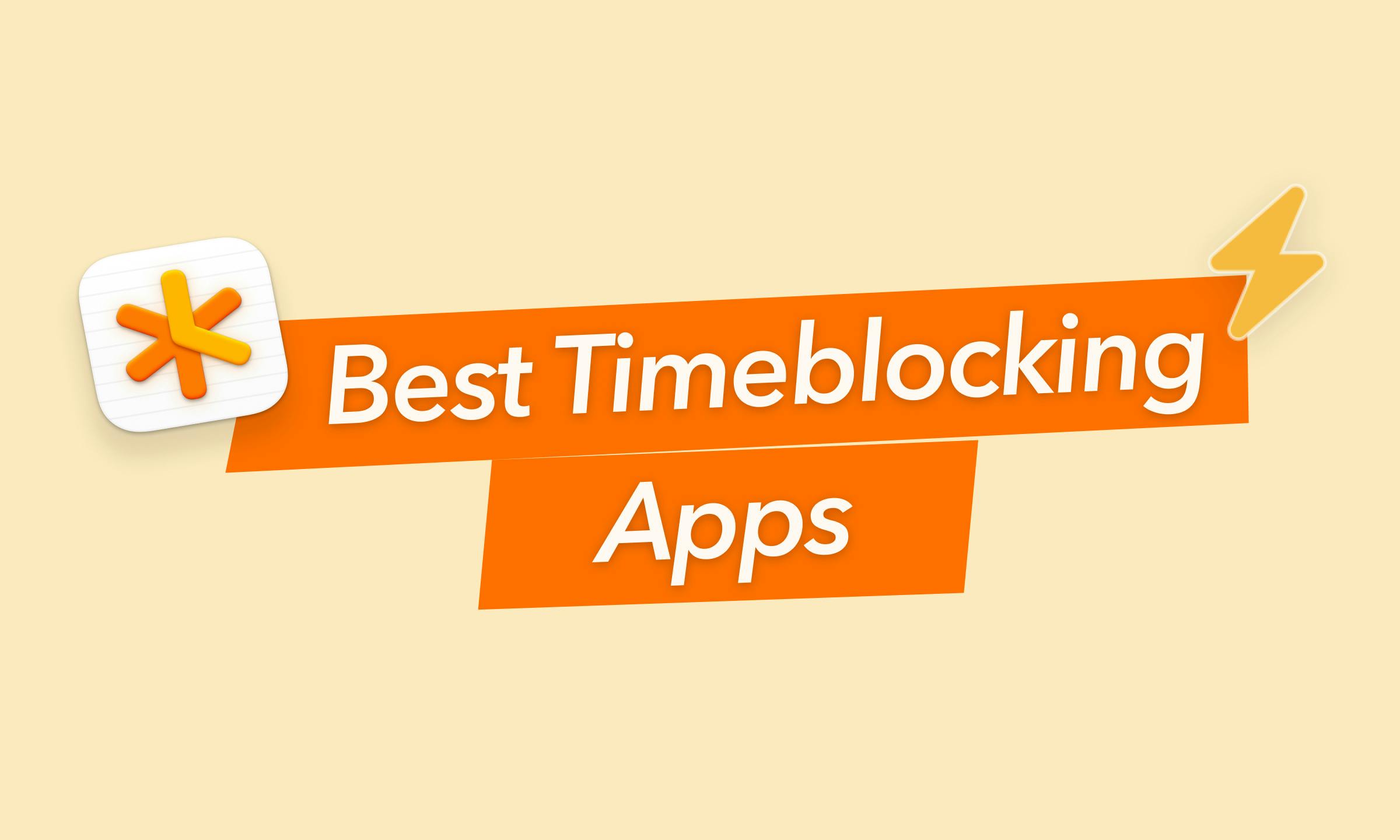
What is Time Blocking?
Time blocking is a powerful time management technique that involves scheduling your day into distinct blocks of time, each dedicated to a specific task or activity. Instead of simply creating a to-do list, the time blocking method involves allocating specific time slots for each item, transforming your schedule into a visual roadmap of your day.
This method offers a structured yet flexible approach to time management, allowing you to proactively manage your hours and minutes instead of constantly reacting to them.
Definition of Time Blocking
Time blocking is a time management technique that involves scheduling fixed, uninterrupted blocks of time for specific tasks or activities. This approach helps individuals prioritize their tasks, manage their time more effectively, and increase their productivity.
By allocating specific time slots for tasks, time blocking enables users to focus on a single task without distractions, leading to better work quality and reduced stress.
Why time blocking works as a time management technique:
- Mindful Time Management: Time blocking forces you to become acutely aware of how you spend your time. By assigning specific time slots to tasks, you gain a clearer understanding of where your time actually goes, making it easier to identify and eliminate time-wasting activities.
- Prioritization Powerhouse: It's not enough to just know what needs to be done; you need to know what needs to be done first. Time blocking helps you prioritize tasks by requiring you to make conscious decisions about what deserves your attention and when. This ensures that important tasks get the dedicated focus they need.
- Productivity Booster: By dedicating specific time slots to individual tasks, you minimize distractions and encourage deep work. With a clear plan in place, you're less likely to get sidetracked by emails, social media, or other interruptions, leading to increased productivity and a greater sense of accomplishment.
Benefits of Time Blocking for Productivity
Time blocking offers numerous benefits for productivity, including:
- Improved Focus and Concentration: By dedicating specific time blocks to individual tasks, you can minimize distractions and maintain a high level of focus.
- Enhanced Prioritization and Task Management: Time blocking forces you to prioritize tasks and allocate time based on their importance and urgency.
- Increased Productivity and Efficiency: With a clear plan in place, you can work more efficiently and complete tasks faster.
- Better Time Estimation and Management: Time blocking helps you estimate how long tasks will take and manage your time more effectively.
- Reduced Stress and Anxiety: Knowing exactly what you need to do and when can reduce the stress and anxiety associated with a disorganized schedule.
- Improved Work-Life Balance: By scheduling time for both work and personal activities, you can achieve a better balance between the two.
- Enhanced Creativity and Innovation: Allocating dedicated time for creative tasks can lead to more innovative ideas and solutions.
- Reduced Procrastination and Distractions: Time blocking helps you stay on track and avoid procrastination by providing a structured schedule.
By incorporating time blocking into your daily routine, you can experience significant improvements in your productivity and overall well-being.
A brief look back:
While time blocking may seem like a recent trend, the concept has been around for decades. Early proponents include Benjamin Franklin, who meticulously planned his days, and Dwight Eisenhower, whose Eisenhower Matrix prioritization method aligns perfectly with time blocking principles.
In recent years, time blocking has experienced a resurgence in popularity, fueled by productivity experts and the increasing demands of our fast-paced world. It's a simple yet effective technique embraced by professionals, entrepreneurs, and anyone striving to enhance their productivity and achieve their goals.
How Time Blocking Works
Understanding the concept of time blocking
Time blocking, at its core, is about intentionally allocating specific periods of time to specific tasks. It's like creating a personalized schedule for your day, where each activity has its own designated "appointment."
This shifts your mindset from passively reacting to tasks as they arise to proactively dictating how your time is spent.
How to implement time blocking in daily routine
Start with a Brain Dump:
Before diving into your calendar, take a moment to capture everything vying for your attention. Jot down all your tasks, appointments, errands, and even personal to-dos like "meal prep" or "call mom." This "brain dump" clears your mind and ensures nothing gets forgotten.
Prioritize and Categorize:
Now, look at your list and prioritize. What are the absolute must-dos for today? What can be pushed to tomorrow or later? Consider using a prioritization method like the Eisenhower Matrix (urgent/important) to guide your decisions. As you prioritize, group similar tasks together – bundle your errands, phone calls, or creative work.
Choose Your Time Blocking Tool:
Find a tool that fits your style. Digital calendars like Google Calendar or Outlook offer flexibility and reminders, while paper planners provide a tangible overview. You can even use a combination – a digital calendar for appointments and a paper planner for detailed daily time blocking.
Block Out Your Time:
Begin by blocking time for your morning routine, whether it’s exercise, meditation, or simply enjoying a quiet coffee. Create a calendar event for your most demanding tasks when your energy levels are highest – these are your “deep work” blocks. Allocate time for less demanding tasks like emails and admin work. And don’t forget to include breaks, meals, and, importantly, dedicated personal time for hobbies, relaxation, and social interaction.
Be Realistic and Flexible:
Be honest about how much you can realistically achieve in a day. Avoid overscheduling, and remember that life rarely goes exactly as planned. Be prepared to adjust your schedule as needed – if a meeting runs long or an unexpected task pops up, simply rearrange your blocks. Maintaining a time blocked calendar can help you manage your time better by clearly allocating periods for tasks and meetings, defending necessary time for deadlines, and minimizing distractions.
Review and Refine:
At the end of the day or week, take a few minutes to reflect. What worked well with your time blocking approach? What could be improved? Use this feedback to continuously refine your strategy and make time blocking an even more effective tool for managing your time and achieving your goals.
Tips for effective time blocking
To make time blocking truly effective, try theming your days, like "Meeting Mondays" or "Creative Wednesdays", to create structure and flow. Break down large tasks into smaller chunks and schedule dedicated time for thinking and planning.
Be mindful of your energy levels, scheduling demanding tasks for when you're most alert, and use visual cues like color-coding to easily distinguish between activities. Always include buffer time between blocks to account for the unexpected, and allocate time for reactive tasks like emails.
Finally, remember that time blocking is an ongoing process – regularly review and adjust your system as needed to maximize its effectiveness.
Best time blocking apps at a glance
| App | Key Features | Pricing |
|---|---|---|
Notes and tasks integration, time blocking, drag-and-drop. | $9.99/month (7-day free trial) | |
Task management, Google Tasks integration | $5/month | |
Events, reminders, shared calendars | Free | |
Unified schedule view, AI scheduling | $15/month | |
Task/calendar integration, mindful planning | $20/month (14-day free trial) | |
Drag-and-drop, minimalist interface | $9/month | |
Apple integration, recurring events | $4.74/month (14-day free trial) | |
AI scheduling, real-time adjustments | $19/month (7-day free trial) | |
Task blocking, Pomodoro timer | $35.99/year | |
Visual scheduling, Trello integration | $6/month |
Top Time Blocking Apps
NotePlan
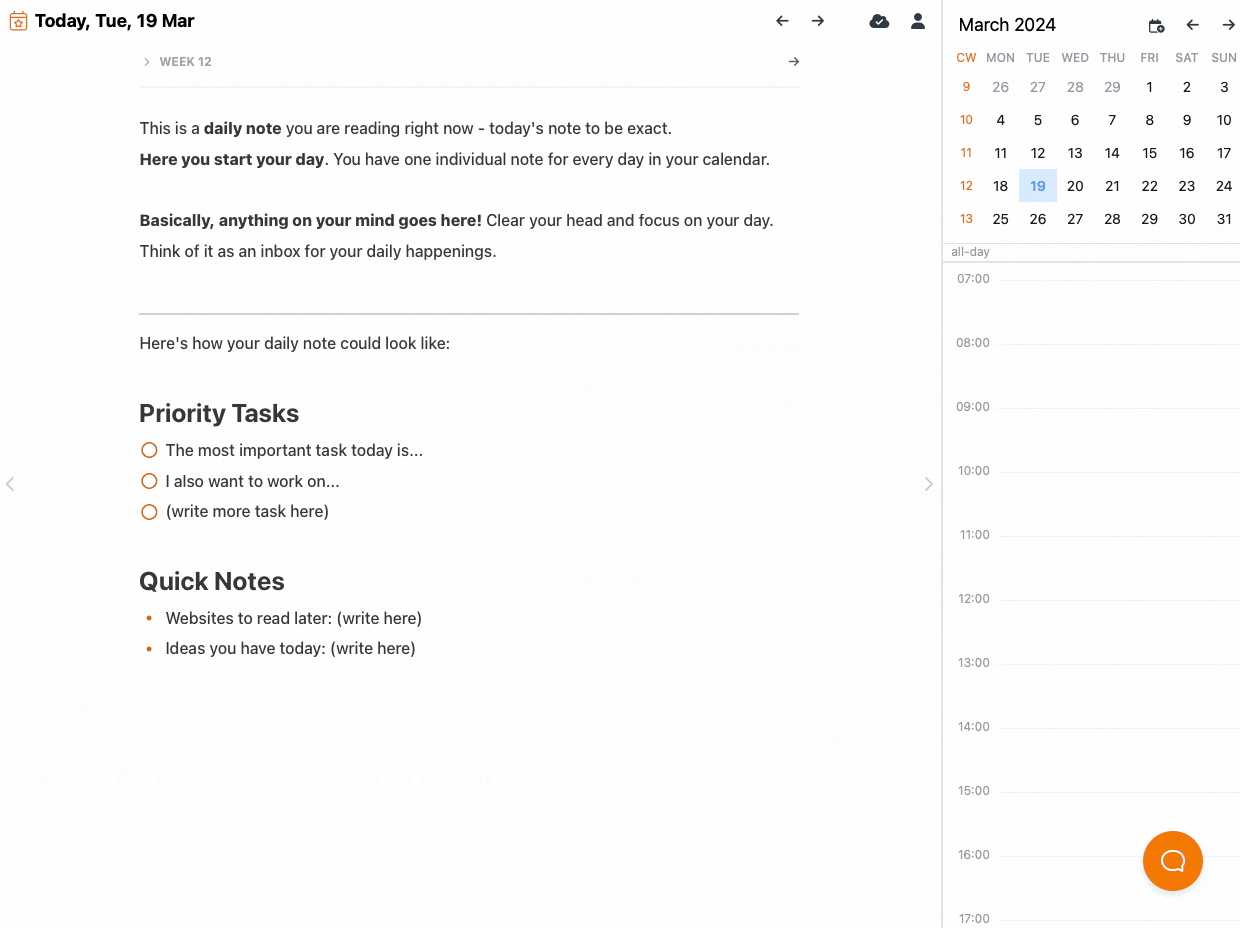
If you’re looking for a powerful time blocking app that seamlessly integrates with your notes and tasks, NotePlan is your ideal solution.
It lets you schedule your day with precision, allocating specific time slots for tasks, meetings, and breaks, all within the context of your daily notes. The time blocking feature in NotePlan helps you organize daily and weekly tasks, maintain focus, and mitigate scheduling conflicts.
With NotePlan, you can effortlessly visualize your schedule, prioritize tasks, and maintain a balanced routine, enhancing your productivity and ensuring you stay on top of your commitments.
Pros
- Seamlessly integrates tasks and notes in one location
- Offers a calendar view for easy time visualization
- Provides flexibility to adjust your schedule with drag and drop functionality
- Supports recurring tasks and events for routine activities
- Simple and clean interface for easy navigation
- Cross-platform compatibility for access across devices
- Markdown support for note-taking flexibility
- Offline functionality ensures accessibility anytime
Cons
- Limited third-party integrations compared to some other apps
- Relies on markdown, which may not suit users preferring rich text formatting
Pricing
- 7 day free trial. Paid plan starting with $9.99/month
Reviews
- App Store: 4.8 out of 5
Todoist
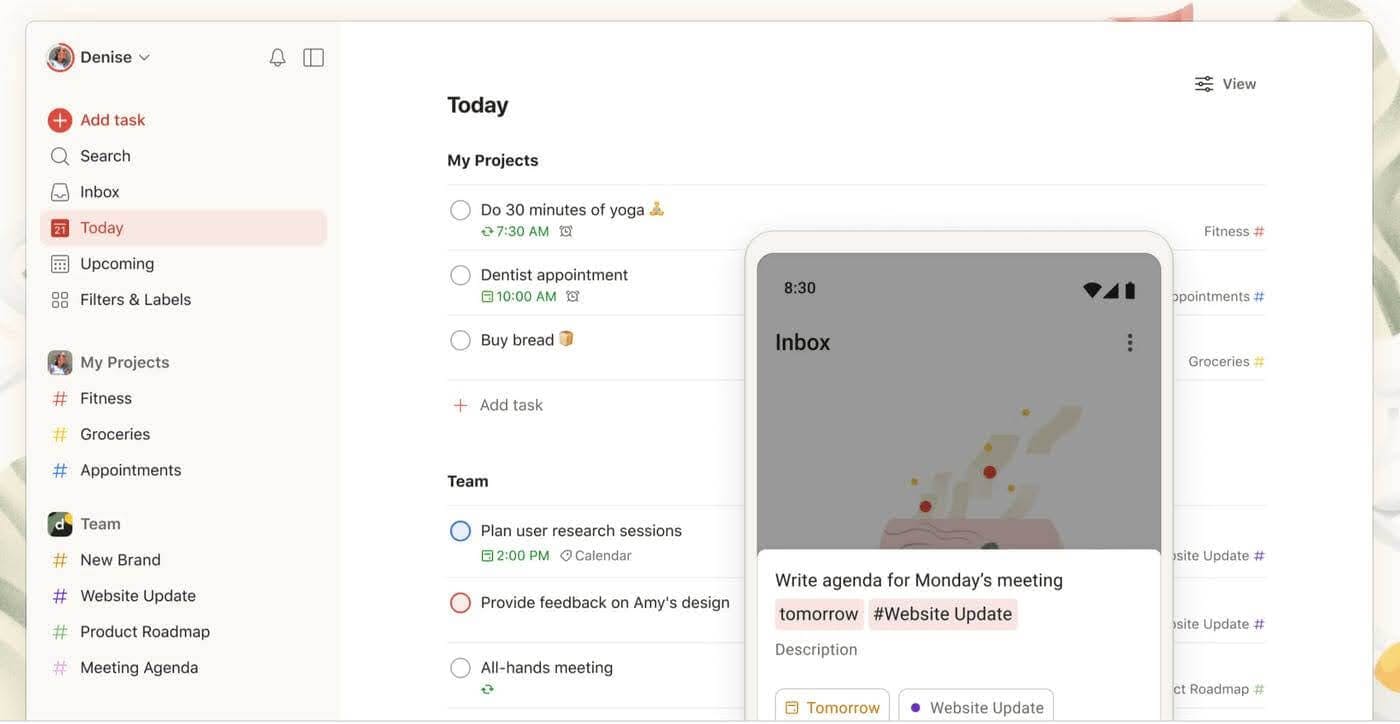
Todoist, while known as a task management app, can effectively be used for time blocking. You can schedule your tasks within specific time slots by adding them to your daily or weekly schedule with due times. Additionally, Todoist integrates with Google Tasks for seamless task management, allowing automatic addition of tasks from Google Tasks to your Todoist schedule.
By dedicating blocks of time to specific tasks, you ensure they get the dedicated focus they need and prevent them from being pushed aside by less important tasks.
Pros
- Seamless task management integration
- Cross-platform availability and synchronization
- Intuitive drag-and-drop interface for scheduling
- Flexibility to adjust blocked time slots as needed
- Natural Language Processing for quick task entry
Cons
- Limited visual representation of blocked time compared to dedicated calendar apps
- No built-in functionality for recurring time blocks
- Can become cluttered if not organized diligently
- Lacks advanced features like automatic scheduling or overlapping time block warnings
- May require integration with a calendar app for a comprehensive view of your schedule
Pricing
- Free Plan. Paid plan starting with $5 billed monthly
Reviews:
- App Store: 4.8 out of 5 (111.9k)
- Google Play: 4.5 out of 5 (273.9k)
Google Calendar

Google Calendar provides a visual and intuitive platform for time blocking. You can create color-coded blocks for various tasks and detailed calendar events, gaining a clear overview of your schedule.
Easy integration with other Google services, reminders, and the ability to share your calendar make it a convenient choice for staying organized and collaborating with others.
Pros
- Familiar and widely accessible interface
- Excellent visual representation of your schedule
- Easy to create and adjust time blocks
- Strong collaboration features with shared calendars
- Integrates seamlessly with other Google services
Cons
- Limited task management features compared to dedicated to-do apps
- Can be less flexible for detailed task organization within time blocks
- May not be ideal for complex projects with many subtasks
- Basic features can feel limiting for advanced users
- Potential for privacy concerns with data stored on Google’s servers
Pricing
- Available for free with a Google Account
Reviews:
- App Store: 4.6 out of 5 (120.5k)
- Google Play: 4.6 out of 5 (3.3M)
Morgen
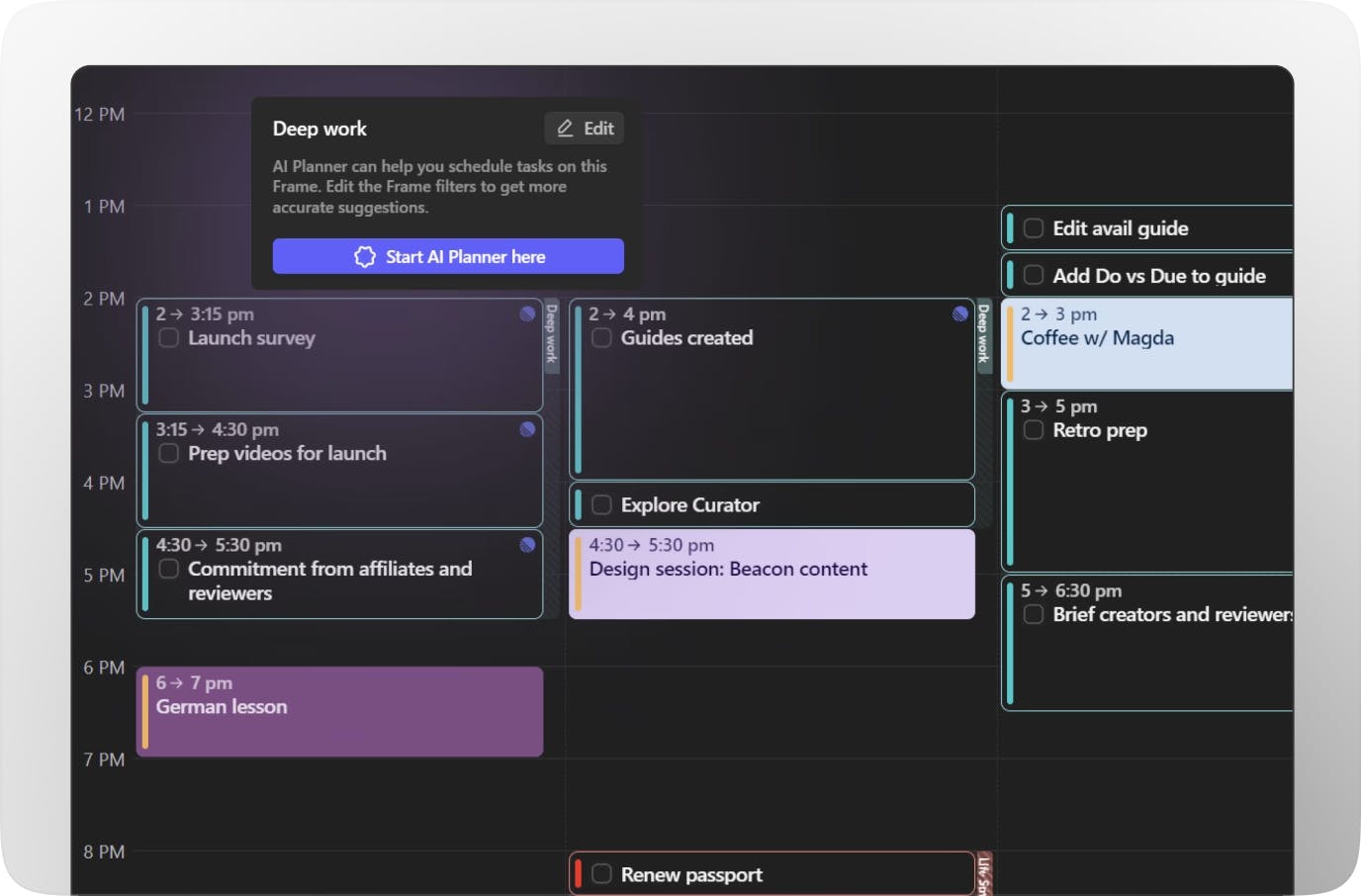
source: morgen.so
Morgen streamlines your time blocking by integrating with your existing calendars and to-do lists. You can drag and drop tasks directly into your schedule, set time limits for focused work, and even share your availability for meetings with a unique scheduling link.
Morgen helps you visualize your day, manage your tasks effectively, and maintain a healthy work-life balance with features designed to prevent burnout. It excels in scheduling tasks by offering AI scheduling and integration options that enhance productivity.
Pros
- Integrates with existing calendars and to-do list apps
- Offers a unified view of your schedule and tasks
- Streamlines scheduling with a shareable availability link
- Includes features for focused work and preventing burnout
- Provides flexibility to customize your workflow
Cons
- Reliance on integrations with other apps for full functionality
- Can be overwhelming for users who prefer a simpler interface
- No offline functionality
- May not be as widely known or used as established alternatives
Pricing
- Free Plan. Paid plan starting with $15 billed monthly
Reviews:
- App Store: 4.4 out of 5 (122)
- Google Play: 4.4 out of 5 (295)
Sunsama
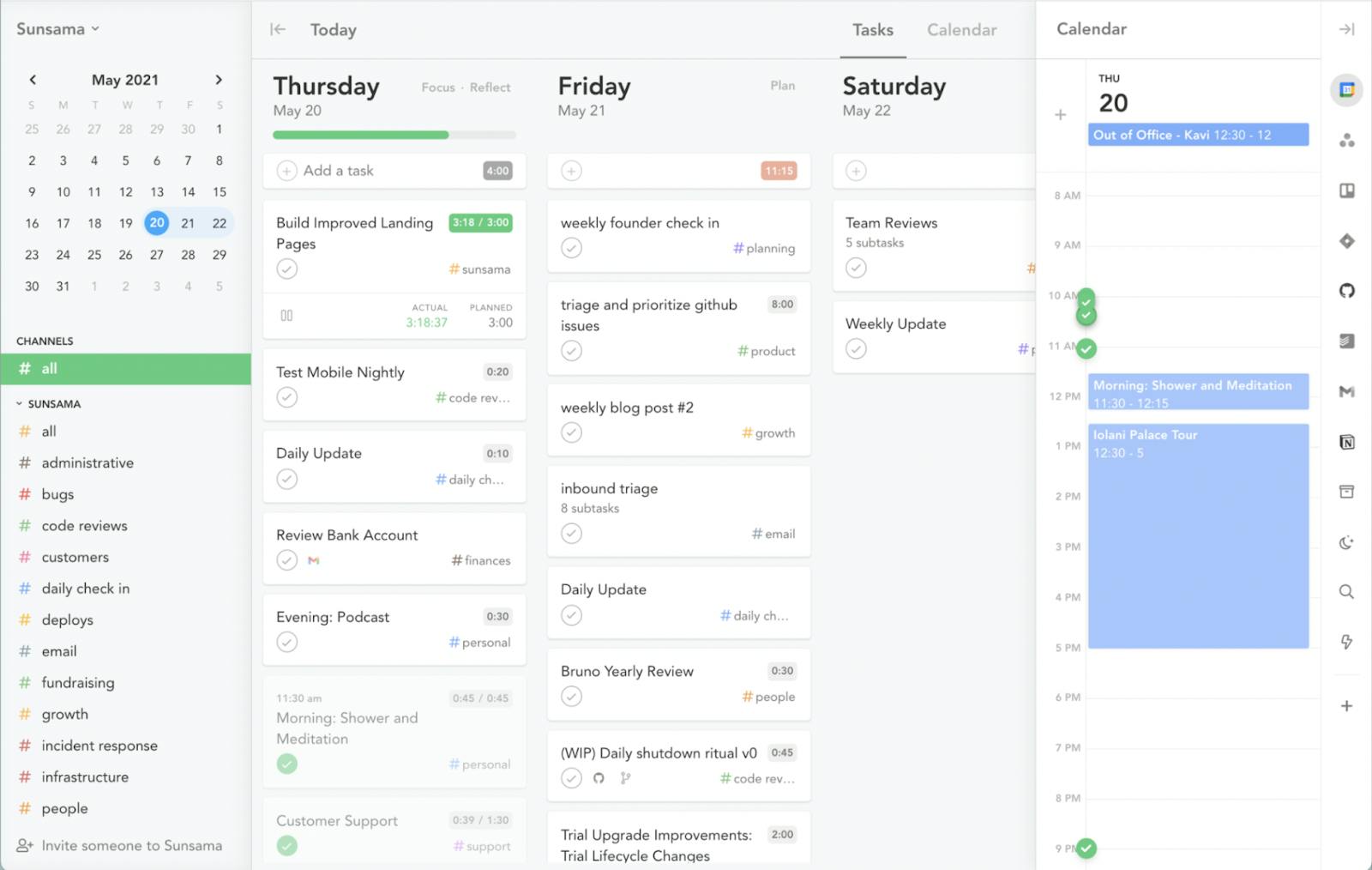
Sunsama is a daily planner that combines your tasks and calendars for focused time blocking. Drag and drop tasks, schedule meetings, and track your daily progress.
Sunsama integrates with various task managers, enhancing productivity by allowing users to manage tasks and schedules more effectively. Integrations with tools like Slack and Gmail keep you connected, while daily prompts encourage mindful planning and prioritization, helping you achieve a better work-life balance.
Pros
- Integrates with popular task management and calendar apps
- Provides a structured daily planning framework
- Encourages mindful work with prompts and reflection features
- Offers a clean and intuitive interface
- Includes features for team collaboration and communication
Cons
- Can be expensive compared to other time blocking apps
- May feel restrictive for users who prefer more flexibility
- Mobile app functionality is limited compared to the desktop version
- No offline access to your schedule or tasks
Pricing
- No free plan available. Paid plan starting with 14 day free trial, then $20 billed monthly
Reviews:
- App Store: 3.8 out of 5 (124)
- Google Play: 3.0 out of 5 (176)
TimeBloc
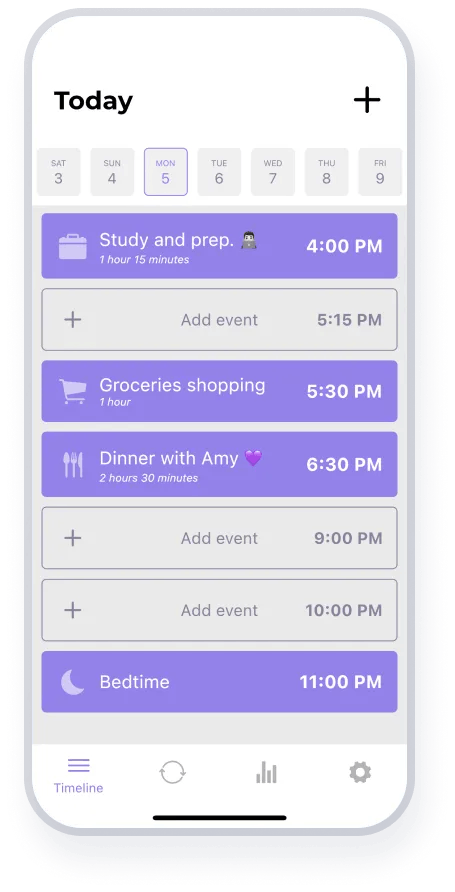
TimeBloc simplifies time blocking with its drag-and-drop interface and pre-set time blocks. You can easily create a visual schedule and stay on track with its minimalist design.
While it lacks integrations with other apps, its simplicity makes it ideal for beginners or those seeking a dedicated time blocking solution.
Pros
- Simple and intuitive interface
- Easy to use drag-and-drop functionality for scheduling
- Minimalist design minimizes distractions
- Affordable pricing with a one-time purchase option
- Focuses solely on time blocking without unnecessary features
Cons
- Limited functionality compared to more comprehensive apps
- Lacks integration with calendars and to-do lists
- No collaboration or sharing features
- Limited customization options for appearance and functionality
- May not be suitable for complex schedules or projects
Pricing
- Free Plan. Paid plan starting with $9 billed monthly
Reviews:
- App Store: 4.3 out of 5 (7.1k)
- Google Play: 2.7 out of 5 (1.3k)
Fantastical

Fantastical streamlines your time blocking with an intuitive interface and powerful features. Schedule events and tasks naturally, create recurring events with flexible options, and view your schedule in various formats, from day timelines to week views.
Seamlessly integrated with Apple devices, Fantastical enhances planning with weather forecasts and meeting proposals.
Pros
- Natural language processing for effortless event creation
- Beautiful and intuitive interface with multiple view options
- Excellent integration with Apple ecosystem and services
- Powerful features for managing recurring events and tasks
- Includes useful additions like weather forecasts and meeting proposals
Cons
- Limited cross-platform compatibility (primarily focused on Apple devices)
- Advanced features can have a learning curve
- May not be suitable for users seeking a simple, basic calendar
- Lacks deep integrations with third-party task management applications
Pricing
- 14 day free trial. Paid plan starts from $4.74 per month billed annually
Reviews:
- App Store: 3.9 out of 5 (3.9k)
- Google Play: Not available
Motion
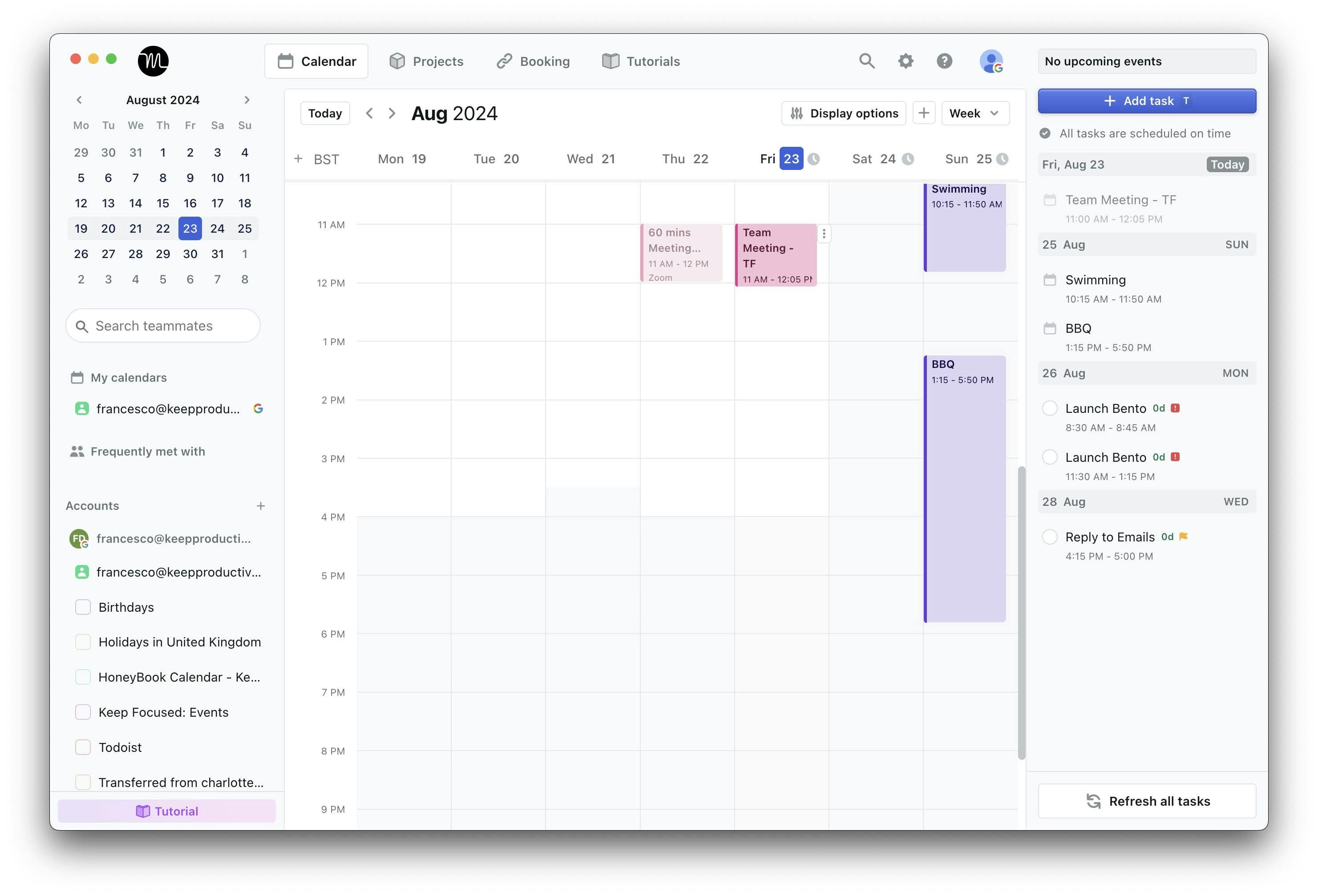
Motion automates your time blocking with AI. Simply input your tasks and appointments, and Motion creates an optimized schedule, dynamically adjusting it in real-time for maximum productivity. Motion also integrates with various time tracking apps for optimized scheduling.
While it requires giving up some control, Motion is a powerful tool for those seeking to optimize their time and reduce scheduling stress.
Pros
- Automates scheduling and optimizes your time based on priorities
- Reduces the mental overhead of manual time blocking
- Dynamically adjusts your schedule in response to changes and new tasks
- Helps you focus on deep work by minimizing distractions
- Integrates with popular calendars and project management tools
Cons
- May not be suitable for users who prefer a more hands-on approach
- Limited customization options for the scheduling algorithm
- Potential for unexpected or undesirable schedule changes
- Relies on accurate task estimations for optimal performance
- Can have a learning curve to understand and utilize its features effectively
- Privacy concerns with sharing sensitive data with the AI engine
Pricing
- 7 day free trial. Paid plan starting with $19/month
Reviews:
- App Store: 4.7 out of 5 (111)
- Google Play: 3.8 out of 5 (1k)
TickTick
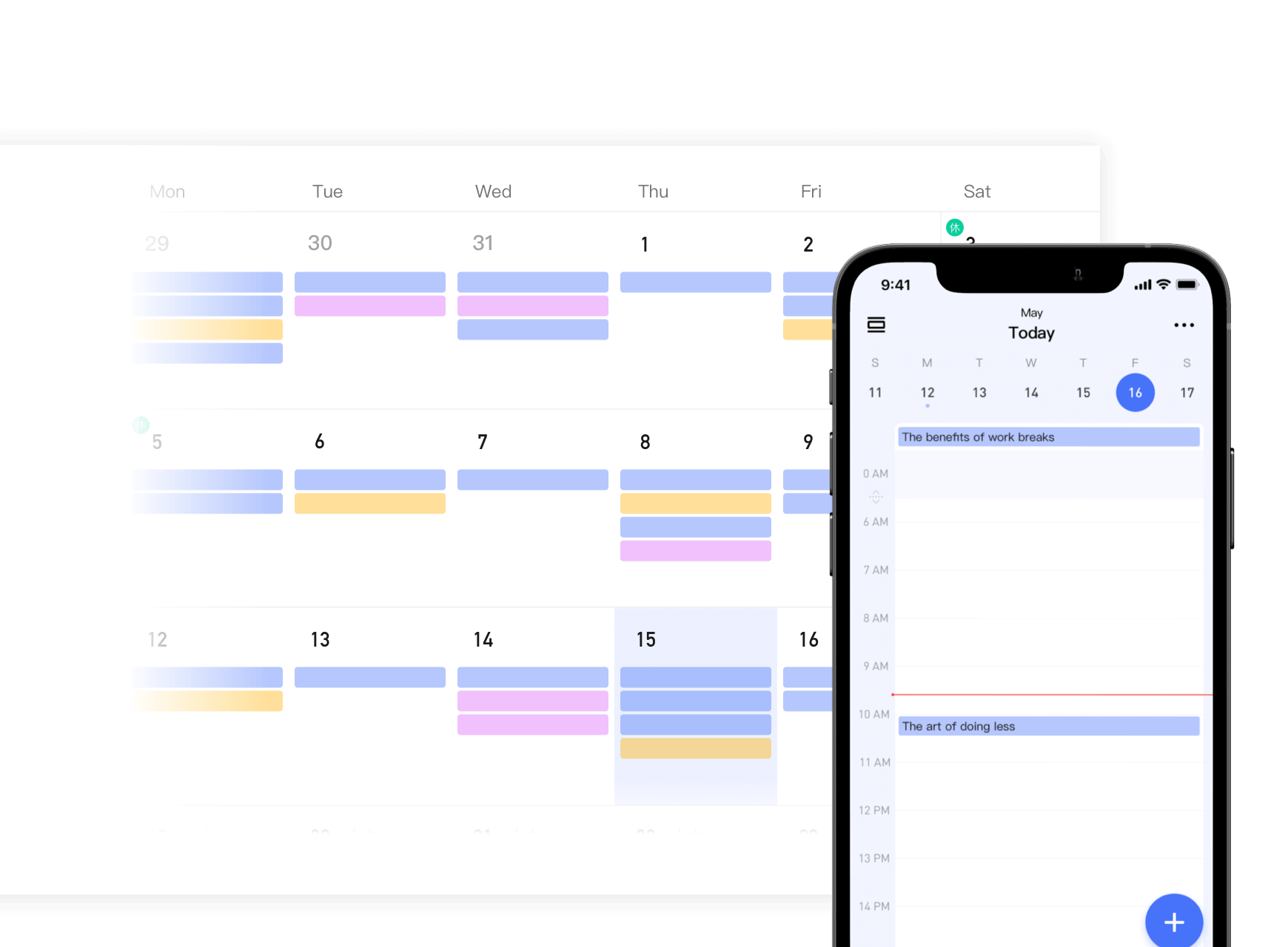
TickTick combines task management with effective time blocking. Create tasks and assign them to specific time slots in your calendar, set reminders, and utilize the Pomodoro timer for focused work.
With cross-platform availability and customizable features, TickTick seamlessly integrates time blocking into your workflow for enhanced productivity.
Pros
- Combines robust task management with time blocking capabilities
- Offers a flexible and customizable system for organizing tasks and schedules
- Provides a Pomodoro timer for focused work sessions
- Available across multiple platforms with seamless synchronization
- Affordable premium subscription with a generous free tier
- Includes features like habit tracking and white noise for enhanced productivity
Cons
- Time blocking features are not as visually prominent as dedicated calendar apps
- Can become cluttered if not organized effectively
- Limited functionality for managing complex projects or team collaborations
- May require integration with a separate calendar app for a comprehensive overview
- Lacks advanced features like automatic scheduling or conflict detection
Pricing
- Free plan. Paid plan starts with $35.99 billed annually
Reviews:
- App Store: 4.9 out of 5 (31k)
- Google Play: 4.6 out of 5 (137k)
Planyway
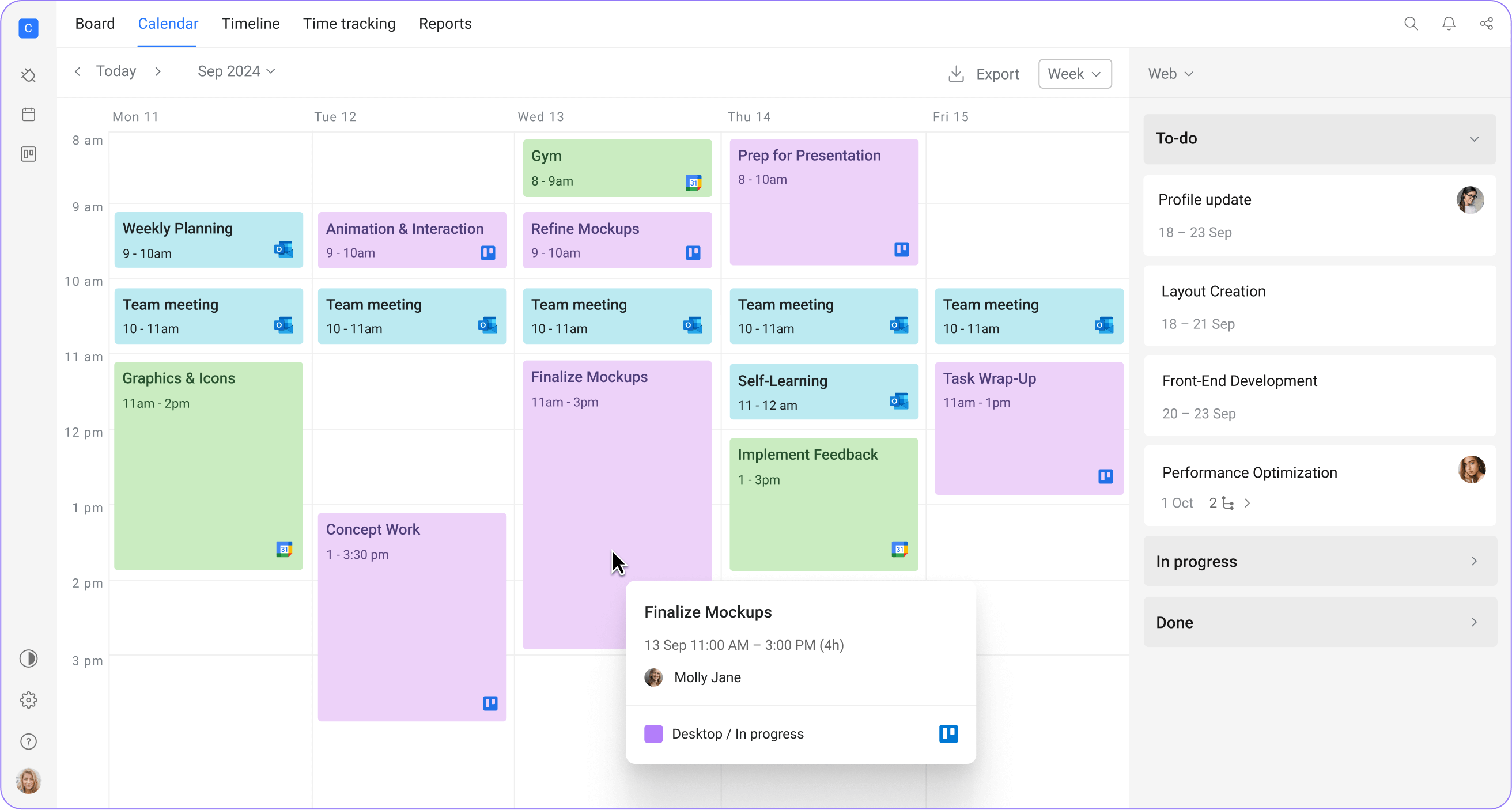
Planyway brings visual time blocking to your favorite project management tools like Trello, Asana, and Jira. Drag and drop tasks onto your calendar, allocate time, and visualize your workload in a timeline or calendar view.
Planyway helps you schedule effectively and track progress without switching between apps.
Pros
- Integrates directly with popular project management platforms like Trello, Asana, Jira, and Monday.com
- Provides a visual overview of your tasks and schedule within your existing workflow
- Facilitates better task prioritization and time allocation
- Offers different views for visualizing your schedule, including daily, weekly, and monthly calendars
- Allows for easy drag-and-drop scheduling and rescheduling of tasks
- Improves team collaboration and coordination on shared projects
Cons
- Relies on existing project management tools, limiting its use as a standalone time blocking app
- May not be suitable for individuals with less complex scheduling needs
- Limited customization options for the interface and features
- Can have a learning curve, especially for users unfamiliar with the integrated project management platforms
Pricing
- Free Plan. Paid plan starting with $6 billed monthly
Reviews:
- App Store: 4.5 out of 5 (105)
- Google Play: 4.2 out of 5 (509)
Time Blocking App Features to Consider
When selecting a time blocking app, consider the following features:
- Calendar Integration: Look for seamless integration with Google Calendar, Apple Calendar, or other calendar apps to keep all your events and tasks in one place.
- Task Management: Ensure the app allows you to create and manage tasks, including setting due dates and reminders.
- Time Tracking: A feature to track the time spent on tasks and activities can help you analyze and optimize your schedule.
- Scheduling: The ability to schedule tasks and meetings easily is crucial for effective time blocking.
- Customization: Options to customize time blocks, including duration, frequency, and priority, can make the app more flexible to your needs.
- Notifications: Reminders and notifications help you stay on track and ensure you don’t miss any important tasks or events.
- Reporting: Features to track progress, including time spent on tasks and activities, can provide valuable insights into your productivity.
- Integration: Integration with other productivity apps, such as project management tools and to-do lists, can enhance the app’s functionality and streamline your workflow.
Conclusion
Time blocking is a powerful technique that can transform your relationship with time, helping you achieve greater focus, productivity, and balance in your daily life. By intentionally allocating specific periods to specific tasks, you gain control of your schedule instead of letting it control you. Remember to start small, be flexible, and continuously refine your approach.
With the right time blocking strategy and the assistance of the top 10 apps we'll explore in this article, you can unlock new levels of productivity and make meaningful progress towards your goals in 2025.
Can one app really replace your entire productivity stack?
NotePlan did. Try NotePlan free for 7 days to learn how